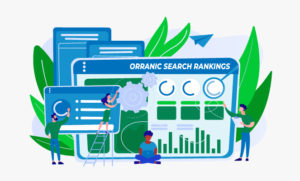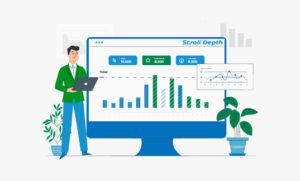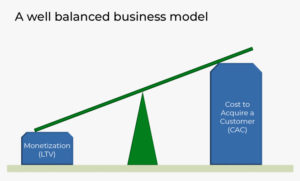Among marketers, there’s not much dispute that, when done right, content marketing is one of the most powerful long-term marketing strategies available to businesses. In fact, content marketing is so effective that over 85% of marketers create content designed to attract, nurture, and ultimately convert leads into customers.
The problem, however, is that not all content is created equal. Just because you create a blog post or social media graphic doesn’t mean that it’s effective. In order to gauge the effectiveness of a piece of content (or a campaign), you need to measure it against Key Performance Indicators (KPIs).
However, this raises another challenge: which KPIs matter most when it comes to content marketing? There are literally dozens, if not hundreds to choose from depending on the type of content you’re producing.
In this guide, we’re going to walk you through 11 of the most important content marketing KPIs to track.
11 Content Marketing KPIs To Track
Content marketing consists of multiple strategies (blogs, videos, social media posts, etc.), and depending on the type in question, some KPIs will be more relevant than others.
For example, if you’re analyzing the performance of a landing page, you’re looking at things like click-through-rate, leads generated, etc. With a social media post, you’re looking at engagement metrics, like clicks, comments, shares, etc.
Ultimately, the content marketing KPIs that you track need to be closely tied to the goal of the individual piece of content, as well as your overall content marketing goals. With that being said, let’s look at some individual metrics you should be paying attention to.
1. Total site traffic
Your website is your home base online. Almost all content marketing has the ultimate goal of driving people back to your site. Your total site traffic helps you evaluate the effectiveness of your content marketing efforts. If your website experiences a noticeable uptick in traffic related to a particular piece of content or campaign, you know your marketing efforts have delivered results.
We’ll get into this more in a minute, but when looking at total site traffic numbers, it’s important to make sure you’re getting the right traffic. An increase in traffic doesn’t do you any good if it doesn’t translate into more leads and sales.
If you see a surge of traffic without an accompanying increase in leads and revenue, it probably means you’re attracting the wrong audience. Either the content itself or the way you’re promoting it is bringing in people who ultimately aren’t interested in your product or service.
For example, if you’re creating SEO-driven blog posts, it may mean that you’re targeting the wrong keywords. Or if you’re using Facebook Ads to drive traffic to a piece of content, you’re targeting the wrong audience with your ads.
All this said, total site traffic is important. Just make sure newly acquired traffic is driving your business goals.
2. Organic search rankings
To state the obvious, sites that organically rank higher in search results will ultimately receive more visitors than those that rank lower. Aside from directly impacting sales, search rankings can tell you quite a bit about specific pieces of content and how well they’re performing.
Google pays a lot of attention to how visitors interact with different pages on your site. They look at things like how long people stay on a page, whether people click through to other pages, and whether people click on your site in the search results. All these things tell Google whether the page is valuable to visitors. The algorithm is designed to reward quality content with higher search result rankings and ignore poor quality content.
If you see a piece of content steadily increase in the search result rankings, it’s an indicator that it is performing well with visitors and related to similar content.
3. Organic search traffic
Organic search traffic measures the volume of traffic to your site as a result of specific keywords. Your goal is to get as much relevant organic search traffic as possible. The key word here is “relevant”. Like total site traffic, you want organic search traffic that is directly related to your business goals. Getting organic traffic for irrelevant keywords doesn’t help your business.

If you want to increase your organic traffic, you have two options:
- Create new content around new keywords
- Improve existing content so that it outperforms other content ranking for the keywords you’re targeting
For example, if you want to rank for the phrase “best protein bars” and don’t have any content targeting that keyword, you could create an in-depth blog post optimized for those, and other relevant keywords. If you already have a page targeting that phrase but it’s not getting as much traffic as you’d like, take a look at the pages that are ranking well and then look for ways to improve your page so that it’s better than the competition.
4. Time on page
As we noted above, page views and visits only tell part of the picture, and don’t give you the full picture regarding how effective a piece of content is. This is where time on page (aka dwell time), comes into play. If individuals spend a significant amount of time on a page, you can assume that they see the content as engaging and worthwhile.
Typically, a short time on page indicates that content is irrelevant, non-engaging, or doesn’t deliver what it promises. When this is the case, it’s time to go back and look for ways to improve the content. More times than not, the issue falls into one of two camps. Either the content is poorly done or it isn’t relevant to the audience.
The solution is either to significantly improve the quality of the content so that visitors want to consume all of it or to reshape the content so it’s more relevant to the intended audience.
There is one caveat to this that should be mentioned. If you see a high time on a page but a relatively low conversion rate (compared to other pages), it probably means that the content is good but is attracting the wrong audience. If this is the case, you need to take a step back and reevaluate your content strategy to ensure that what you’re producing matches up with the needs and desires of your audience.
5. Scroll depth
One of the limitations of time-on-page is it doesn’t guarantee that users are actually consuming content. For this reason, it’s helpful to combine the time-on-page metric with scroll depth so that you can better assess the performance of a piece of content.

As the name implies, scroll depth percentage looks at how far down a page a visitor scrolls. If visitors are landing on a page on your site but not scrolling far down, it’s an indicator that the content isn’t particularly engaging. On top of this, scroll depth can be used to determine the most common point people stop reading a piece of content and then make adjustments so that the entire piece is more engaging.
Perhaps the first half of a blog post was quality and informative, and the second half veered off-topic. Or maybe the content was simply too long and visitors lost interest. Whatever the case, scroll depth is an important KPI to track, especially on things like blog posts.
6. Backlinks from other sites
A backlink is simply when a website links back to your site from their site. When measuring backlinks, there is the total number of backlinks and links from unique domains. If a website links back to you 10 times, that’s considered 10 backlinks from one unique domain.
Now, why do backlinks matter? Because they’re a signal to Google that a piece of content is trustworthy and authoritative. The more referring domains from relevant websites that a piece of content has, the more likely it is to rank higher in search results. Additionally, relevant backlinks strengthen the overall total “authority” of your website, and sites with higher authority tend to rank much higher than those with few or no backlinks.
If a piece of content is published and begins to rack up the backlinks, it tells you that the content is valuable and users are willing to engage with it. If your content isn’t getting any backlinks, you need to rethink your content strategy and look for ways to create high-value content that is linkworthy in the eyes of others.
7. Social shares
Social shares are a valuable content marketing KPI to pay attention to. Several reasons for this.
First, when someone shares a blog post, article, or video, it appears under their name, meaning they feel the content is valuable enough to endorse it personally. If your content is getting a significant number of social shares, it indicates that a lot of people find it valuable and want to share it with others in their network.
Second, social shares lead to site traffic (assuming the content is on your site and not posted natively). The more social shares a piece gets, the more traffic comes to your site.
When you see a high number of social media shares for a particular piece of content, you know you did something right. If your content isn’t getting shared much (relative to the size of your audience), you need to ask why. It may help to use a tool like Buzzsumo, which allows you to see the most shared pieces of content around any subject.
8. Leads
One of the most common reasons content marketing is done for lead generation. Usually this involves users being invited to download a lead magnet of some sort in exchange for their contact info. It can also persuade users to sign up for an event, like a webinar, or simply opt-in to a mailing list.

One of the best ways to measure a piece of contents performance is by tracking how many leads it generates.
If a piece isn’t generating leads, then it’s either not ‘valuable enough to convince people to give you their contact information or the way it’s presented (like on a landing page) isn’t compelling.
9. Conversions
Conversion rates are one of the most important metrics when it comes to content marketing. The definition of what constitutes a conversion will depend on both the type and goal of a piece of content. A conversion could be signing up for a webinar, downloading a lead magnet, or even purchasing a product.
Whatever the goal, it’s essential that conversions be closely tracked. If your content marketing isn’t ultimately producing conversions, then it’s not working. With all your content marketing efforts, determine what constitutes conversions, track your conversion rates, and optimize wherever possible.
10. Customer acquisition costs (CAC)
Customer acquisition cost (CAC) tells you how much it costs you to acquire a new customer. There is total CAC, as well as individual CAC metrics for specific marketing campaigns, channels, and strategies.
The simple way to calculate CAC is:
CAC = (Marketing Costs + Sales Costs) / Customers Acquired

It’s critical to measure CAC for several reasons. First, you need to ensure the costs of acquiring new customers through content marketing are in line with the lifetime value (LTV) of those customers. If you’re spending more to acquire customers than you’ll make back over the lifetime of your relationship with them, you’re going to run out of money eventually.
Second, tracking CAC helps you know which content marketing strategies are most cost-effective. For example, you may learn that CAC through organic search is significantly lower than it is through PPC ads. Armed with this information, you can double down on what’s working and either optimize or abandon strategies where the CAC is too high.
11. Overall ROI
Ultimately, ROI is the metric that matters most when it comes to content marketing. If you’re not getting a solid return on your content marketing, then it’s clearly not working.
Exactly how you calculate ROI will vary depending on your content marketing goals, industry, and other factors. But when all is said and done, you need to be able to determine the return on the amount you invested into content marketing.
If the return isn’t high enough, then you need to take a close look at the strategies you’re using and look for ways to reduce costs and improve performance.
Measure So You Can Manage
The old adage that you can’t manage what you don’t measure is certainly true when it comes to content marketing KPIs. If you don’t closely track the most important metrics, you won’t know whether your efforts are successful. You may end up wasting large amounts of time and money on ineffective strategies and miss out on strategic opportunities.
So track, measure, manage, optimize, and repeat. The more you do this, the better you’ll get at content marketing and the higher your ROI will be.
Rocket Pilots Digital Marketing
Rocket Pilots is a digital marketing agency specializing in law firm internet marketing, lawyer SEO, websites for lawyers, and more. If you need help with your content marketing efforts, don’t hesitate to contact us today.
